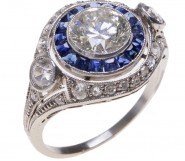Lot #13 - Russell Drysdale
-
Auction House:Mossgreen
-
Sale Name:The Alan & Margaret Hickinbotham Collection
-
Sale Date:25 Jun 2017 ~ 2pm (Australian Central Standard Time)
-
Lot #:13
-
Lot Description:Russell Drysdale
(1912-1981)
Dancing Children No. 1, 1949
oil on canvas
30 x 40 cm
signed lower right: Russell Drysdale; inscribed RUSSELL DRYSDALE, c/-Macquarie Galleries 19 Bligh St Sydney on frame verso; label Art Gallery of New South Wales verso: Russell Drysdale Retrospective 1937-1960/Dancing Children No.1/Cat.no.63/Art Gallery of New South Wales, October 5 to November 1960; White chalk on frame verso, Blaxland -
Provenance:By 1955 Collection Mrs Gregory Blaxland; Australian Paintings, Christie's, Melbourne, 28 April 1976, lot 488; Private Collection
-
Exhibited:Society of Artists, Sydney 1949; Sydney, Society of Artists, 1949 Sydney, Art Gallery of N.S.W., Art Gallery Society Loan. Exhibition, 1955, Sydney, Art Gallery of N.S.W., Russell Drysdale Retrospective 1937 1960, Oct.-Nov. 1960, cat. no. 63
-
References:Russell Drysdale: A retrospective exhibition of paintings from 1937 to 1960, Art Gallery of New South Wales, Ure Smith, Sydney, 1960; James Gleeson, ‘Russell Drysdale’, Art Gallery of New South Wales Quarterly, Vol.2, No.1, October 1960; Geoffrey Dutton, Russell Drysdale, Thames & Hudson, 1964; Lou Klepac, Russell Drysdale, Murdoch Books, revised ed.,1996; Dancing Children No.1, Illustrated, Plate 101, p.286; Ure Smith, Russell Drysdale's Australia, 1974, pl. I
-
Notes:Related Work: Children Dancing No 2, 1950, oil on canvas, 63.5 x 101.6 cm; By 1969, Collection Mervyn Horton, Sydney; Private Collection; Children in a Bath Tub, lot no. 30 this sale Dancing Children No.1 belongs to a group of key works by Russell Drysdale that feature children, beginning with the arresting double portrait Two Children (1945-46) (National Gallery of Victoria). The group includes another version of the present work, Children Dancing No.2, (Private Collection), in which the landscape stretches back to an old iron windmill in the distance. Anonymous as generic portraits, Drysdale’s young people serve as a counterpoint in his oeuvre to the seemingly exhausted, world-weary adults who inhabit the harsh and virtually featureless terrain of the Australian outback. These country folk present a resigned and stoic acceptance of the harsh realities of life, meaning poverty and at times desperation within the context of a land made barren by perpetual drought; but in contrast to their melancholy, the children as seen in Dancing Children No.1 delight in the simple pleasures of singing and dancing with the joy of youth, finding amusement in whatever they can within the empty, alien landscape. The overpowering emptiness and airlessness of this environment and its sense of all pervading silence, prompted the artist and critic James Gleeson to note that, ‘When Drysdale paints two children dancing in a desert, they do not dance together, as children do, in joy, to music; they dance alone, in separate worlds of silence, and we are made to feel that the awkward agitation of their limbs comes from an imperative need to break, for a moment, the deadly stillness in which they live’. 1 The decade of the 1940s was a defining period for Russell Drysdale in which, against the backdrop of war and drought, he emerged as one of Australia’s most significant artists of the modern era, producing works that resonated with both ‘the luminosity of a dream and the grit of reality’.2 After studying with George Bell in Melbourne (1935-37) and spending time in London and Paris, Drysdale took on board the lessons of the Old and Modern Masters along with the aspects of Surrealism contained in both Henry Moore’s biomorphic shapes and Graham Sutherland’s eerie primordial landscapes. All of which contributed to his ability back in Australia to capture the emotional essence of a specific place, together with the existentialist anxieties of its inhabitants. In this sense Drysdale’s paintings of the outback, produced after he was commissioned by the Sydney Morning Herald newspaper in 1944 to travel with a journalist to western New South Wales to record the effects of what was believed to be the worst drought in history for that region, reverberate with his sympathetic understanding for the people he encountered and observed. The experience provided him with a vast array of images that served as inspiration for a powerful series of works reflecting the hardship of the terrain and the dignity, tenacity and stoicism of people living in the harsh conditions of rural Australia. Dancing Children No.1 is thus a seminal work in the trajectory of Russell Drysdale’s oeuvre that truly defined the ‘Australian experience’. Frances Lindsay AM 1 James Gleeson, ‘Russell Drysdale’, Art Gallery of New South Wales Quarterly, Vol.2, No.1, October 1960, p.39, quoted in Lou Klepac, Russell Drysdale, Murdoch Books, revised ed.1996, p. 160; 2 Patrick McCaughey, Foreword, Russell Drysdale Drawings 1935-1980, Joseph Brown Gallery, March 1981.
-
Estimate:A$220,000 - 250,000
-
Realised Price:
-
Category:Art
This Sale has been held and this item is no longer available. Details are provided for information purposes only.










